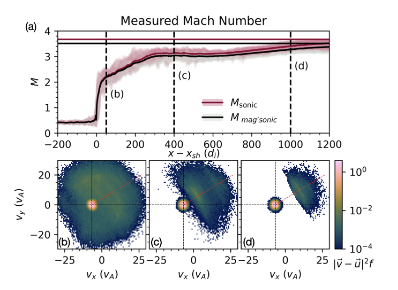C.C. Haggerty, D. Caprioli, P.A. Cassak, M.H. Barbhuiya, L. Wilson III, D. Turner
Abstract: Collisionless plasma shocks are a common feature of many space and astrophysical systems and are sources of high-energy particles and non thermal emission, channeling as much as 20% of the shock’s energy into non-thermal particles. The generation and acceleration of these non-thermal particles have been extensively studied, however, how these particles feed back on the shock hydrodynamics has not been fully treated. This work presents the results of self-consistent hybrid particle-in-cell simulations that show the effect of self-generated non-thermal particle populations on the nature of collisionless, quasi-parallel shocks. They contribute to a significant heat flux density upstream of the shock. Non-thermal particles downstream of the shock leak into the upstream region, taking energy away from the shock. This increases the compression ratio, slows the shock down, and flattens the non-thermal population’s spectral index for lower Mach number shocks. We incorporate this into a revised theory for the Rankine-Hugoniot jump conditions that include this effect and it shows excellent agreement with simulations. The results have the potential to explain discrepancies between predictions and observations in a wide range of systems, such as inaccuracies of predictions of arrival times of coronal mass ejections and the conflicting radio and x-ray observations of intracluster shocks. These effects will likely need to be included in fluid modeling to accurately predict shock evolution.
Read the full text: https://arxiv.org/pdf/2307.12423.pdf

0 Comments